
8 Most Effective Marketing Channels for Mobile Apps
Are you ready to spend extra cash to promote your mobile app? If yes, then you should look into paid marketing channels.
However, it is a must that you know your options. Whether you have a limited or overflowing flow of cash, you don’t want to spend your money in the wrong channel, right?
That’s why, in addition to knowing what paid marketing channels are, and which of them are available out there, you need to understand how they work, their pros and cons, features, and how they can bring success to your mobile apps.
Thankfully, you don’t have to go elsewhere to know the answer.
In this post, you will know the different paid marketing channels and how each of them can help you grow your business.
What are the marketing channels for mobile apps?
Marketing channels can be service providers, platforms, or websites that offer marketing solutions. There are different types of marketing channels and mostly, they will differ in their specialization.
Marketing channels can be free while others are paid. Usually, free marketing channels only come with basic features. If you want to fully take advantage of a marketing channel, you will most likely need to pay for it.

This post will focus more on paid marketing channels for mobile applications.
When it comes to mobile apps, there are different premium marketing channels you will most likely encounter. Some of them are great while others are not so great.
You just have to weigh your options to know which paid marketing channels would be best for your business goals.
With this in mind, here are the best paid mobile marketing channels you should try:
1. App Store Optimization
First off our list are app stores. It is only natural to first look into them since we are talking about mobile apps.
When you think of app stores, you would most likely think of two app stores: Google Playstore and Apple App Store.
That’s something expected because outside of China, Google Play and Apple App Store control 95 percent of the app store market.

However, did you know that there are actually more app stores available today?
Here are some of them in alphabetical order:
-
- ACMarket
- Amazon Appstore
- Aptoide
- F-Droid
- GetJar
- Huawei App Store
- Samsung Galaxy Apps
- SlideME
- Sony Apps
- Uptodown Market
There are so many apps out there, but we don’t have time to mention all of them. Nevertheless, we are going to focus first on two of the most popular app stores and get an overview of how their paid advertising works.
Before that, you need to understand how to ensure you get your app in front of your users. With so millions of mobile apps available in the Google Play and Apple App Store alone, you will soon realize how difficult it is to rank your app.
Thankfully, that’s where App Store Optimization comes in.
App Store Optimization, or known as ASO, is a marketing strategy that allows you to increase your app’s visibility in app stores, thereby improving your installs and conversion rate.
ASO involves a lot of things. It includes tweaking different aspects or elements of your app store listing to ensure they are optimized and ready to convince people to use your app.
These app store listing elements include app title, app name, app icon, images, rating, description, videos, and others.
There’s so much to learn. Thus, you may want to read, “The Practical Guide To App Store Optimization (ASO)”
2. Paid User Acquisition/Advertising
Paid user acquisition simply means you pay service providers who will help you acquire more users. As simple as that sounds, there are different goals and strategies for user acquisition or advertising.
There are different paid user acquisition channels available today. They are basically available on the Internet and show themselves as a platform that could help build your traffic.
Just to keep you going, let me share a few of them:
A. Google UAC/Google App Campaigns
In 2021 alone, there will be about 111.3 billion mobile apps downloaded on Google Playstore. As you can see, there’s a huge market in Google Play.
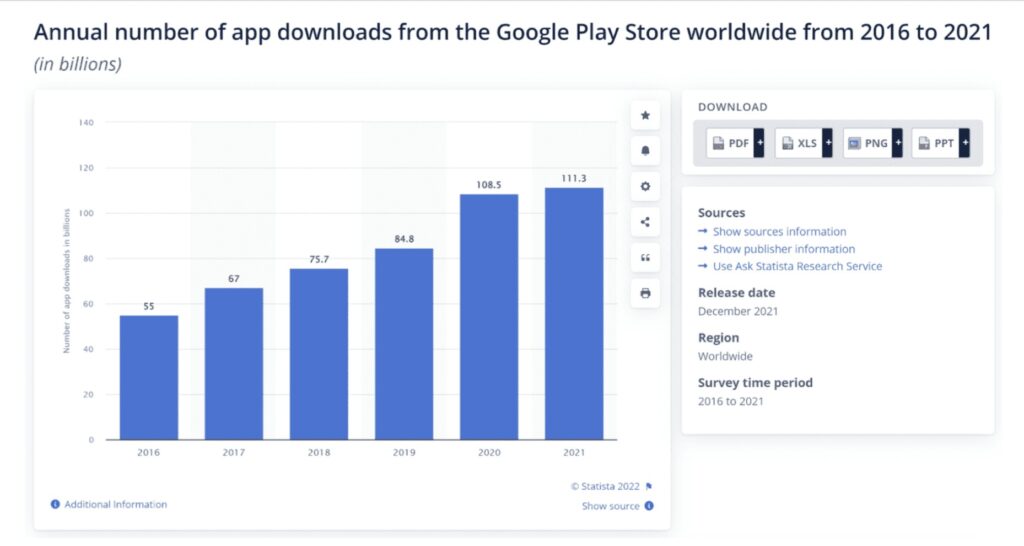
The problem is that competition is fierce and you might have a hard time getting your mobile app in the forefront of users.
Thankfully, Google Play offers App campaigns, and its specific ad program for mobile apps.
How does the app campaign work?
Google makes it as easy as possible for you to promote your app. What’s so neat about App campaigns is that you can promote your app not just on Google Play but also on Google Search, Google Discover, Google Display Network, and YouTube.
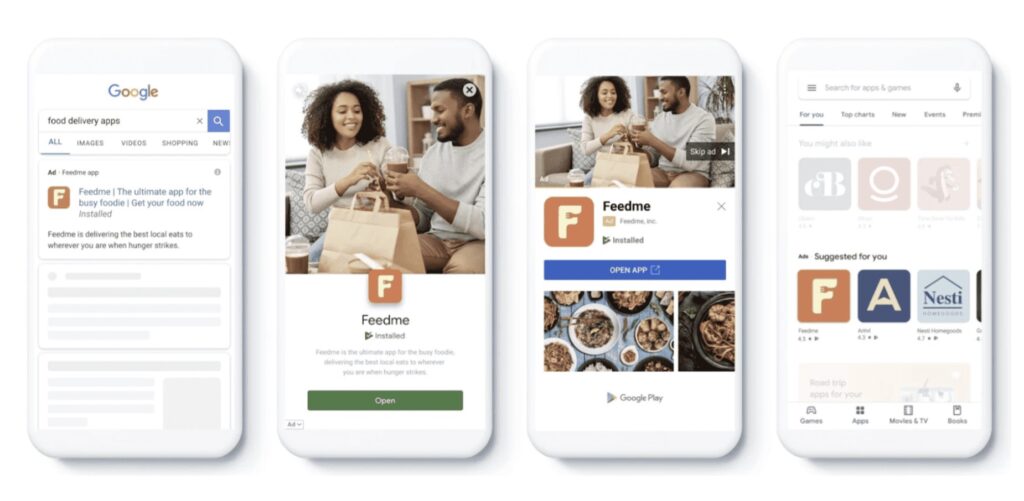
With Google app campaigns, there’s no need for you to create individual ads, which is something commonly done in Google Ads campaigns.
What happens is that Google will use your available videos, images, text ideas, and other assets found in your app’s store listing. Google will then design various ads for you.
To start your app campaign, you will simply need to specify the following:
- Text, image, or video you want to appear on your ad
- budget and bid
- Language
- Location
There are then three app campaign types you can choose from. The type of your app campaign will determine the focus of your ads.
Here are the app campaign types:
- App engagement
- App installs
- App pre-registration
To start using Google App campaigns, you simply need to sign in to your Google Ads account. From there, you need to click Campaigns in the page menu, click the plus button, select New campaign, and then App promotion for your campaign goal.
B. Apple Search Ads
There are about 3.6 million apps in the Apple App Store. According to some estimates, there are about 500,000,000 million people who visit the platform each year. Thus, it is only logical for you to consider advertising your mobile app on the Apple App Store.
The search ads are a good example of paid user acquisition because you are actually paying Apple, the owner of the App Store, to help you out in getting more installs and users.
According to Business of Apps, the average cost per tap (CPT) on the Apple platform is $0.93. However, it can go up as high as $1.75 for other more expensive app categories such as shopping and finance.

The paid advertising program of the Apple Store is Apple Search Ads. If you’re using this program for the first time, you can use it for free with 100 USD credit.
There are two basic plans for Apple Search Ads. These are the following:
Basic
This uses intelligent automation to help you maximize your result and reduce time setting things up. With just a few easy steps, you can have your ads up and running.
With Basic, you only pay for the downloads. You also get an intuitive dashboard to quickly get an overview of your ad performance.
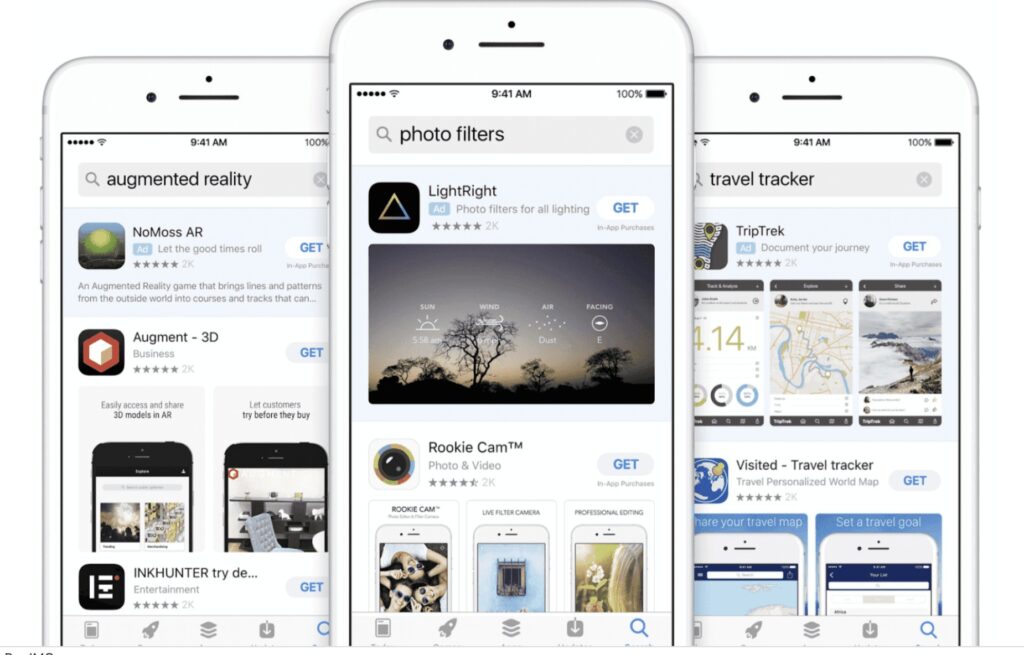
Advanced
The Advanced plan allows you to get additional placement options for your ads. You can have your ads placed on Search tabs and also, at the top of search results.
There’s greater flexibility as well. You can choose which audience you want to target and how much you want to spend. The dashboard is also powered with more metrics using Apple’s APIs.
Why use Apple Search Ads?
While you might already have an idea of what Apple Search Ads is, it’s still worth learning the different reasons why you should choose it. Here are some of them:
High conversion rate
Did you know that the majority of Apple App Store users don’t actually browse the store but rather use the search function?
That’s right. According to Apple itself, 70% of their app store users use search to find their needed app. Aside from that, 65% of all downloads that happen in the app store are made after a search is made.
So, it only makes sense that if you want people to find your mobile app, you need to put it in search results. That’s why it’s not surprising that the average conversion rate for search results ads is 50%.
Higher retention rate
Through its sophisticated and precise algorithm of Apple, they can show your ads to the right people at the right time. Because of this, you don’t simply get discovered by any users or customers, but rather, a highly targeted and engaged group of people.
A high retention rate means that there’s a lower chance your users will uninstall your app. They will use your app for a longer time and get more engagement from them.
Increased revenue
In a case study made by Apple, they discovered that with Search Ads, a mobile app can increase its downloads by as much as 30% in a single month. Taking into consideration all the benefits of Search ads, mobile developers have seen an 18% increase in their revenue.
If you wish to learn more, you need to read, “How to deploy Apple Search Ads for optimal results in 2022.”
C. Snapchat
When you combine a great camera app and messaging app, what you’ll get is Snapchat. According to Statista, Snapchat has over 300 million users. So, you can just imagine how many customers or users you can potentially get from this app.
The main paid user acquisition program is called Snapchat Ads. Through this program, advertisers like you can reach anyone around the world with impressive results.
If your app is specially made for Gen Zs and millennials, Snapchat is a good advertising channel for you. On average, Snapchat users stay in the app for at least 30 minutes.
What’s great about Snapchat Ads is that you can start with as little as $5 a day. With this low spending requirement, you can easily test your ads and learn how to better improve your marketing effort without breaking the bank.
D. TikTok
If you have been following the ranking of social media platforms, you would most likely see the magical rise of TikTok. At the time of this writing, there are over a billion users of this video-sharing app, and TikTok is poised to become a worthy challenger to Facebook and YouTube.
TikTok is a great choice to promote your apps if you:
- Are targeting a younger audience
- Want to build a strong presence in the Middle East and Asia
- Are looking for more female users
There are different types of TikTok ads, which include in-feed ads, video ads, image ads, spark ads, carousel ads, and pangle ads.
E. Facebook
There are almost 3 billion people who use Facebook. So, how can you tap into this rich avenue of users and customers?
To do this, you first need to create a Facebook page for your business or app. From there, you can select “Promote,” choose a goal, choose your ad creative, create an audience, set budget and duration, review, and submit!
It’s as easy as that. Facebook’s algorithm is also among the best in advertising. This means that you can be sure that you can target the right people for your app.
F. Instagram
Another herculean social media platform is Instagram. It has about 2 billion active users every month. With Instagram, you can run the following types of ads:
- Carousel ads
- Video ads
- Photo ads
- Stories ads
- Ads in Explore
The Instagram ad helps your mobile app to get more exposure. Primarily, Instagram ads appear on Feeds, Explore and Stories and are labeled “sponsored.” Ads seamlessly appear along with other Instagram content and suggested accounts.
G. Twitter
To start advertising on Twitter, you need to create a Twitter Ads account. After signing up, you gain access to Twitter’s feature of setting up, running, and analyzing promoted ad campaigns.
Like on Instagram, Twitter ads come with a label, but at this time, your ads will be labeled as “Promoted.”
Every month, about 300 million users log into Twitter. It’s a great place to find new users. Your mobile app would surely get additional users as you use Twitter ads.
3. Search Engines
The biggest and most popular search engine today is Google. In addition to Google, you also have Bing, Baidu, Yahoo!, and DuckDuckGo.
Now, it is no secret that people use search engines to find content on the Internet and that includes mobile apps. Even if they don’t directly look for apps, if their query is somewhat related to apps, then it’s a great opportunity to increase your visibility.

However, it’s not always easy to get your website or mobile app on the first page of search engine results. Unless you have a super relevant mobile app to the query of the user, you will most likely not rank high in searches.
What you can do is optimize your mobile app for search engines, which may take a lot of time and energy.
Thankfully, there’s a shortcut. You simply have to pay search engines to create ads for you and get your mobile app on top of search engine rankings.
On average, you might pay $1 to $2 per click made on your ads.
As mentioned, Google is the largest and most widely used search engine today. If search engine marketing is your choice, you can start here with Google Ads.
4. Social Media
Among the largest platforms or websites on the Internet would be social media websites. Billions of people flock together on social media. So, you have plenty of eyes that could potentially see your mobile app and download it.

Of course, there are just so many social media platforms out there. Nevertheless, you might consider trying out the top five. Here’s a list and the link to where you can start advertising:
5. Email Marketing
In the digital age, email marketing is still alive. It is among the most effective ways to spread the word about your mobile app.
According to Statista, there will be about 4.4 billion email users in the world by the end of 2022 and this trend will continue to grow in the coming years. In addition to that, there are almost 320 billion emails that people send per DAY in 2021!
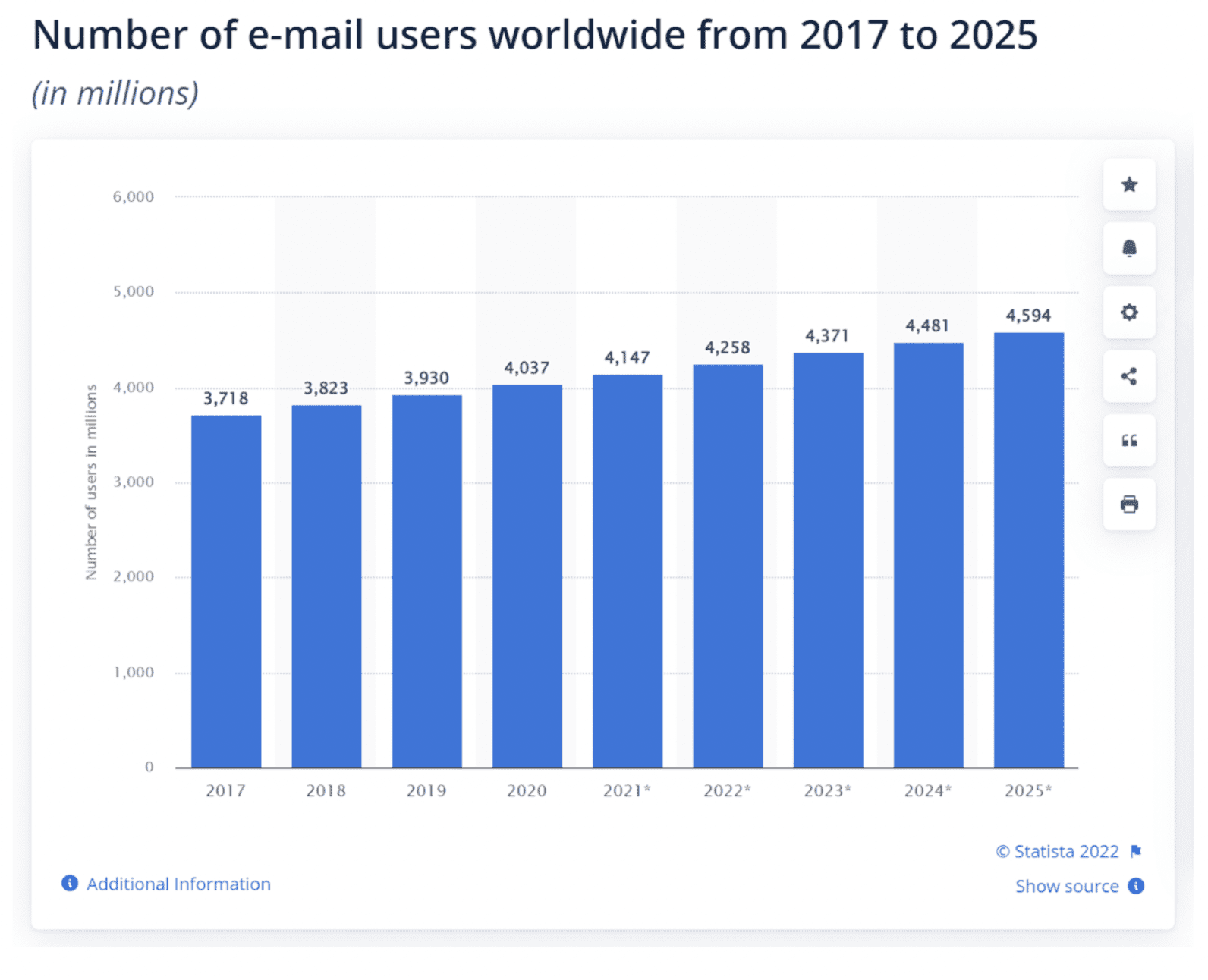
As you can see, email marketing isn’t going anymore and on the contrary, it is still growing.
There are free email marketing services today for you to instantly get started. However, you might eventually want to spend money on your email marketing strategies. Studies show that for every $1 you spend on email marketing, you get $42 in return!
Aside from that, you get 80% customer retention and acquisition with email marketing.
So, it’s really worth a try.
Some of the most popular email marketing service providers are the following:
6. Traditional Marketing
Traditional marketing commonly includes TV commercials, radio stations, and print ads. You may think that traditional marketing strategies are already dead, but you would be surprised that these media still have access to many potential customers.
TV commercials can be among the most expensive channels to promote your mobile app, but it gives you tremendous exposure to your target audience. There’s a reason why the biggest brands and companies still choose TV commercials even though it costs a lot of money.
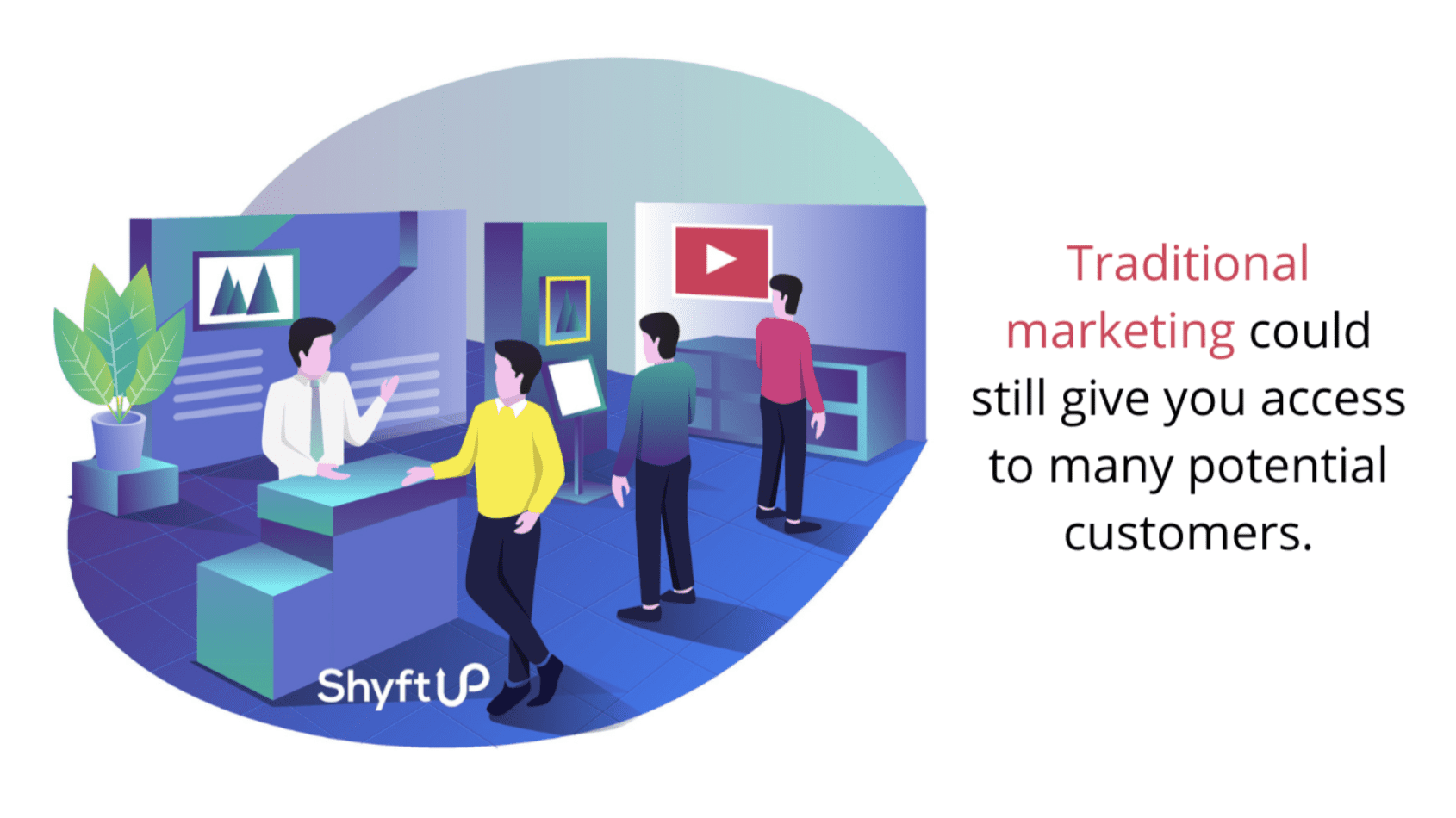
You can start getting in touch with your local TV stations. Check their pricing and see if it would be a great avenue for your mobile app.
Another traditional marketing means would be radio. There’s no doubt that people have changed how they consume media. In recent decades, we have seen how people have migrated from AM/FM radio to other digital forms of music and entertainment.
Under these circumstances, radio stations can still be a cost-effective channel to advertise your mobile app. If you do it right, you may be able to reach a lot of potential customers through radio ads.
Finally, you can try print ads. You can place ads on books, magazines, posters, brochures, and flyers.
7. Affiliate Marketing
Affiliate marketing is simply the process of letting others promote your mobile app and get referrals.
One good example of this is Amazon Affiliates. People create websites and promote products found on Amazon. When their visitors click on their affiliate link and buy through the link, the website owner gets a commission.
That’s basically how affiliate marketing for mobile apps also works.
You might not know it but even Google has its own affiliate program called Google Affiliates. So, affiliate marketing is truly a legitimate channel to promote your app.
What you can do is find websites or platforms that are willing to promote your mobile app for a fee. You can create unique codes or promo codes to track affiliate marketing efforts.
8. Influencer Marketing
There’s no denying that there are more and more influencers on the Internet. They are the people who have a huge number of followers and a platform that could easily reach thousands or even millions of potential customers.

You can research your field or niche and find influencers. For example, you can reach out to celebrities, gamers, bloggers, vloggers, authors, and others.
Some may mention your mobile app in their program for a fee. You can also give them the free stuff in exchange for their endorsement.
Succeed with your mobile app
There’s no doubt that marketing can be lucrative and expensive. However, you simply need to know which marketing channels are the best for you.
With the right research, testing, and checking, you should be able to know which marketing channels are worth your money.
Of course, you can’t blindly make decisions. You need concrete proof and data to ensure you don’t simply spend money without getting anything in return.
Thankfully, you can make better decisions with ShyftUp.
With ShyftUp, you can keep track of the performance of your mobile app. Check whether your marketing campaigns are doing well or not. You can quickly identify what you are doing well and what you’re doing poorly.
Get in touch today and see how ShyftUp can help grow your mobile app!
What is a mobile app marketing channel?
It’s a platform or website that allows you to reach more people and promote your mobile app.
What are mobile marketing examples?
Mobile marketing examples would include search engine marketing, SMS marketing, content marketing, affiliate marketing, and app store marketing.
What are the distribution channels for a mobile app?
Distribution channels for mobile apps include app stores, ad networks, pre-loaded apps, search engine optimization, ad networks, specialist press, app giveaways, and others.